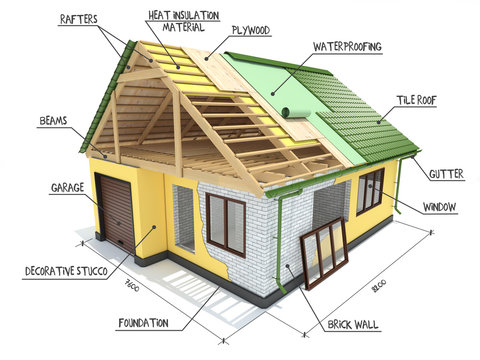The roof of a building serves as its primary shield against the elements, providing protection from rain, snow, wind, and sunlight. Behind its seemingly simple exterior lies a complex structure comprised of various layers, each playing a crucial role in ensuring the durability, insulation, and overall performance of the roof. In this article, we’ll delve into the layers that constitute a typical roof, shedding light on their functions and the importance of a well-constructed roofing system.
1. Decking or Sheathing: The Foundation Layer
The bottommost layer of a roof, often referred to as the decking or sheathing, serves as the foundation for the entire roofing system. Typically made of plywood or oriented strand board (OSB), this layer provides structural support to the roof and serves as the base for subsequent layers. It is essential that the decking is securely attached to the roof framing to ensure stability and load-bearing capacity.
2. Underlayment: The Moisture Barrier
Situated directly above the decking, the underlayment acts as a moisture barrier. Usually made of felt or synthetic materials, this layer protects the roof’s structure from water infiltration. In the event that water breaches the outer layer of the roof, the underlayment prevents it from reaching the decking and causing damage to the roof’s structural integrity.
3. Roofing Material: The Visible Shield
The roofing material is the outermost layer and the most visible component of the roof. It can be composed of various materials, including asphalt shingles, metal panels, tiles, or even living green roofs. The choice of roofing material depends on factors such as climate, aesthetics, and budget. The roofing material serves as the primary defense against weather elements and contributes significantly to the building’s curb appeal.
4. Insulation: Energy Efficiency and Climate Control
Beneath the decking, insulation plays a vital role in regulating the temperature within a building. Insulation materials, such as fiberglass, foam boards, or spray foam, are installed to prevent heat loss in winter and heat gain in summer. Adequate insulation not only enhances energy efficiency but also contributes to the comfort of the living space below the roof.
5. Ventilation: Balancing Airflow
Proper ventilation is crucial for maintaining a healthy and durable roof. It helps prevent the build-up of heat and moisture in the attic space, which can lead to issues such as mold growth, premature deterioration of roofing materials, and increased energy consumption. Vents are strategically placed to allow air to flow, maintaining a balanced environment and extending the lifespan of the roof.
6. Flashing: Water Diversion and Leak Prevention
Flashing is installed in vulnerable areas of the roof, such as around chimneys, skylights, and roof valleys, to divert water away from potential entry points. Usually made of metal, flashing creates a watertight barrier, preventing leaks and water damage in areas prone to water accumulation.
Maintenance and Upkeep:
Regular inspections and maintenance are essential to ensure the longevity and functionality of each layer of the roof. Damaged or worn-out components should be promptly repaired or replaced to prevent issues like leaks, insulation degradation, or structural damage.
Conclusion:
Understanding the layers that constitute a roof provides valuable insight into the intricate system designed to protect your home or building. Each layer serves a specific purpose, and the synergy between these components is crucial for the roof’s overall performance. Whether you’re constructing a new roof or maintaining an existing one. A holistic approach to roof care ensures that your shelter remains secure, energy-efficient, and resilient against the forces of nature.

